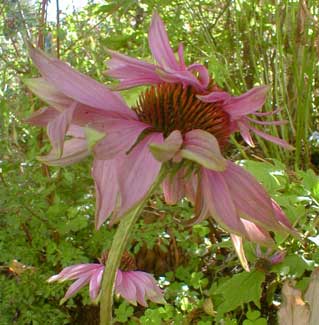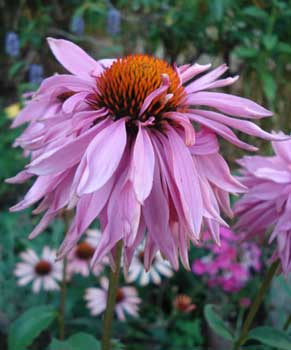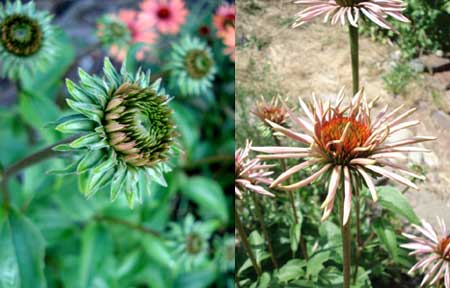
'Doubledecker' or 'Doppelganger'
Tiered Coneflower
"See. Your hand shakes.
It is not palsy or booze.
It is your Doppelganger
trying to get out"
-Anne Sexton
(1928-1974)
(1928-1974)
 The tiered echinacea is marketed in the United States as 'Doubledecker' or less correctly in two words as 'Double Decker' or hyphenated, Double-decker. An identical cultivar 'Indiaca' though purporting to be a separate strain probably should not to be regarded as a distinct variety.
The tiered echinacea is marketed in the United States as 'Doubledecker' or less correctly in two words as 'Double Decker' or hyphenated, Double-decker. An identical cultivar 'Indiaca' though purporting to be a separate strain probably should not to be regarded as a distinct variety.Its also known by the German name 'Doppelganger,' it's actual registered name. It has also been marketed as 'Double Walker,' a clumsily literal translation of 'Doppelganger' which describes a spooky folkoric creature, a ghostly double who haunts its living counterpart.
Some people fear doppelgangers & believe that to meet ones double is an omen of impending death, which may be why it came to be called 'Doubledecker' in the North America & England, to evoke a London bus or a tasty sandwich, rather than something frightening to the superstitious.
A young plant will for its first season produce mostly regular coneflowers, but by its second year it becomes a beautifully unique form, developing a second row of petals on the top of each "cone" creating the doubledecker look, a perfect example shown in the first photo.
 It has a full-sized "regular" skirt of petals reflexed around the bottom of the cone, plus a "hat" or smaller ruffle, umbrella, or headdress springing from the top. This appearance has been described as everything from "charming" to "bizarre" to "wacky."
It has a full-sized "regular" skirt of petals reflexed around the bottom of the cone, plus a "hat" or smaller ruffle, umbrella, or headdress springing from the top. This appearance has been described as everything from "charming" to "bizarre" to "wacky."There is some threat that old clumps will revert to the normal type coneflower, but this might be warded off by dividing the clump every second or third year, in late winter or early spring.
Our oldest mature clump has partially reverted in that the "hat" has migrated down the cone in many of its flowers, so that the skirt of lower petals gets thicker & thicker. An example is shown in the second photo. It's still a phenomenal bloom, & one of the more vigorous fancy coneflowers we have, but it's a little bit too bad the upper decker isn't more stable.
It is additionally a fragrant coneflower, as breeders are striving to build scent into many of the newest varieties.
'Doubledecker' arose as a chance mutation in a German garden of Eugen Schleipfer. To preserve the precise form he began dividing the clump on a regular basis, selecting out the best plants with the doubledecker. Twenty years later the variety was introduced to the whole world.
The blooms begin about mid-July & continue until first frost or later. As the flowers dry out & the petals drop, the dried cones can be left through late autumn & part of winter for their lingering decorative value & so that finches can cling to the sturdy stems & pick out the seeds from the cones. Before new growth appears in spring, whatever remains of the previous year should be trimmed away. It can be trimmed away late in autumn if it has become unsightly.
It's a large echinacea growing thirty to forty inches tall. It's hardy in zones 4-8 & with protection can be stretched to include zones 3 & 9. Like all coneflowers it wants well-draining soil & is very drought hardy when established, but blooms best with moderate watering in sharply draining soil.
Continue to:
'Little Magnus' Echinacea